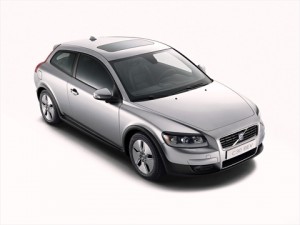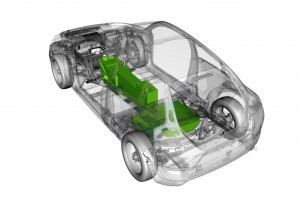Volvo Car’s electrification strategy continues with its confirmation this morning that it is converting a small number of production C30 compact models to battery electric vehicles (EVs) for development and testing.
The Swedish company previously announced that it would offer a line of plug-in hybrids starting in 2012. This, of course, is well behind the auto industry’s ongoing hybridization, which has been underway for more than a decade now, with Toyota producing its third generation of Prius, while Honda is on its second generation Insight.
“The Volvo C30 is the first model we will try out with electric power. This car’s excellent properties in city traffic and its relatively low weight make it particularly suitable, since electric cars are primarily expected to be used in and around cities and for daily commuting,” says Lennart Stegland, Director of Volvo Cars Special Vehicles.
The electric C30 will use lithium ion batteries and has a claimed range of up to 150 kilometers. Recharging an entirely discharged battery with the regular household power ( European 230V, 16A) will take an estimated eight hours.
The electric motor is housed under hood of the C30. One of Volvo’s priorities for the EV project is to find the optimal spot for the battery. It currently thinks the best locations are the tunnel down the middle of the car (GM’s Volt for example) or in front of the rear axle — the place where the fuel tank normally is installed.
Most makers have arrived at these locations since they are within the car’s optimized crumple zone in typical collision scenarios. Since the C30 runs solely on electricity, it requires a much larger battery with higher capacity (24 kWh) than in the case of Volvo’s plug-in hybrid (12 kWh).
EU Regulations Are Forcing Makers into EVs
The European Union is moving ahead — over automakers’ protests — with new CO2 standards for passenger cars that dictate a reduction in average CO2 emissions from new cars to 120 g/km. Fewer than 9% of the cars sold in the EU in 2006 met this level of emissions. The costs of moving towards CO2 of 120 g/km by 2012 through vehicle technology are estimated at about €3,600 ($5,108) on an average per car. (The EU does not recognize light trucks as we do in the U.S., just cars and commercial vehicles. And naturally, there are complicated credits and exemptions or special treatment for cars bought by the wealthy.)
While there is an implementation phase-in for the new EU regulation, it still appears on the surface extremely ambitious — 65% of new cars will comply with requirements in 2012 when the plug-in Volvos appear; 75% in 2013; 80% in 2014 and 100% in 2015.
Since CO2 emissions are directly proportional to the amount of any carbon-based fuel that is burned, CO2 standards can be looked at as fuel economy requirements. But here it is difficult to make clear comparisons since Europe calculates fuel economy on liters of fuel consumed per 100 kilometers driven, different units and the opposite of our miles per gallon method.
The new Volvo C30 DRIVe that debuted in Frankfurt earlier this week has “Start/Stop” technology and uses just 3.8 liters of diesel fuel per 100 km. therefore, it emits just 99 grams of CO2/km. It is cars such as this that present formidable challenges to makers who want to sell (thus far) much more expensive EVs to get emissions credits so they can keep selling larger cars.
Battery capacity
The Volvo C30 BEV is limited to a top speed of about 130 kilometers an hour, which the company hopes will be more than sufficient for most EV users. Acceleration from zero-to-100 kmh will take less than 11 seconds, which is adequate but slower than an equivalent gasoline-engine car.
Volvo says it has theoretically identified all the electrification-related safety scenarios in the stages before, during and after a collision. After studying these scenarios, the company’s engineers will create solutions for handling each situation identified, ensuring that future electric cars match Volvo’s safety standards.
Market Potential?
Volvo Cars’ main electrification strategy over the coming decades relies on plug-in hybrids, especially for its larger car and crossover models. Virtually all makers have arrived at this same conclusion and are in the process of developing plug-in hybrids, even though serious questions remain about their viability. Plug-in hybrids do offer longer range, good not great environmental performance, and rely less on expensive battery technology that will be used in pure EVs.
“The consumer must feel that this type of car is attractive both to drive and own. In order to ensure this, we feel that electric cars will have to be as comfortable and safe and offer similar levels of performance as cars with other power sources. The learning from the C30 BEV project will help us to fulfill all these criteria and showcase Volvo’s determination to drive developments in the field of electrification,” says Paul Gustavsson, Director of Electrification Strategy at Volvo Cars.
While there is an implementation phase-in for the new EU regulation, it appears on the surface extremely ambitious — 65% of new cars will comply with requirements in 2012 when the Volvos appear; 75% in 2013; 80% in 2014 and 100% in 2015. Since CO2 emissions are directly proportional to the amount of any carbon-based fuel that is burned, CO2 standards can be looked at as fuel economy requirements. But here it is difficult to make clear comparisons since Europe calculates fuel economy on liters of fuel consumed per 100 kilometers driven, different units and the opposite of our miles per gallon method.
U.S. Follows EU on C02
The U.S. is also in the process of setting a CO2 standard as part of President Obama’s proposed National Fuel Efficiency Policy, which adopts uniform federal standards to regulate both fuel economy and greenhouse gas emissions. While the outcome is unknown, what is known is that the U.S. fleet must average 35.5 mpg by 2016 with cars at 39 mpg. One estimate says that to get to the 120 gram CO2 limit in Europe, our CAFE would have to go to 48 mpg. But beware of all the numbers being bandied about. MPG numbers are given to much manipulation, especially when it comes to CAFE and or electric vehicles. See 100 MPG: Holy Grail or Hype?
###


